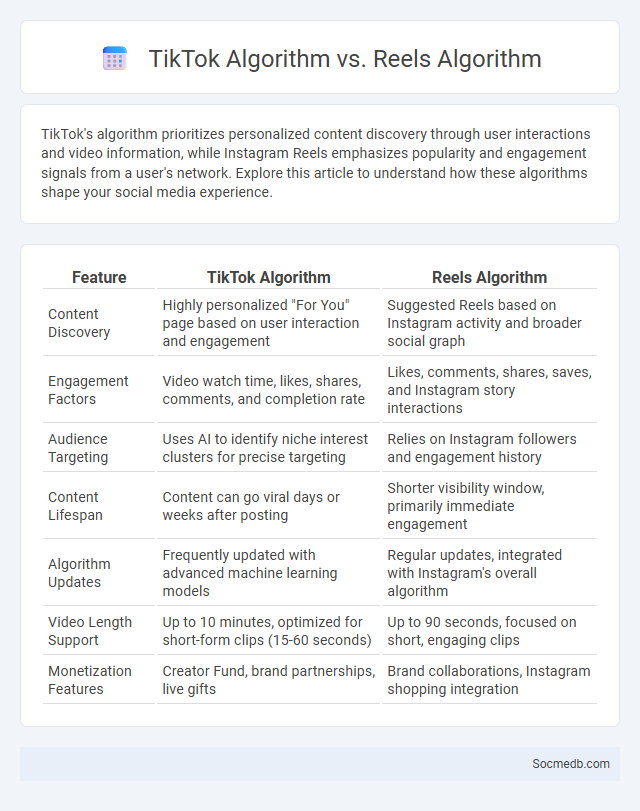
Photo illustration: TikTok Algorithm vs Reels Algorithm
TikTok's algorithm prioritizes personalized content discovery through user interactions and video information, while Instagram Reels emphasizes popularity and engagement signals from a user's network. Explore this article to understand how these algorithms shape your social media experience.
Table of Comparison
| Feature | TikTok Algorithm | Reels Algorithm |
|---|---|---|
| Content Discovery | Highly personalized "For You" page based on user interaction and engagement | Suggested Reels based on Instagram activity and broader social graph |
| Engagement Factors | Video watch time, likes, shares, comments, and completion rate | Likes, comments, shares, saves, and Instagram story interactions |
| Audience Targeting | Uses AI to identify niche interest clusters for precise targeting | Relies on Instagram followers and engagement history |
| Content Lifespan | Content can go viral days or weeks after posting | Shorter visibility window, primarily immediate engagement |
| Algorithm Updates | Frequently updated with advanced machine learning models | Regular updates, integrated with Instagram's overall algorithm |
| Video Length Support | Up to 10 minutes, optimized for short-form clips (15-60 seconds) | Up to 90 seconds, focused on short, engaging clips |
| Monetization Features | Creator Fund, brand partnerships, live gifts | Brand collaborations, Instagram shopping integration |
Overview of TikTok, Reels, and Vertical Video
TikTok, Reels on Instagram, and vertical video formats dominate social media with their engaging, short-form content that caters to mobile users' scrolling habits. TikTok's algorithm excels in personalized content discovery, making it a powerful tool for brands aiming to boost visibility and engagement. Your social media strategy should leverage these vertical video platforms to maximize reach and connect directly with audiences who prefer quick, visually immersive entertainment.
How TikTok Algorithm Works
TikTok's algorithm primarily analyzes user interactions such as likes, shares, comments, and watch time to tailor content that matches Your preferences. By tracking video information including captions, sounds, and hashtags, the platform predicts which videos will engage you most effectively. This dynamic personalization ensures that each user's For You Page is constantly updated with content that aligns closely with Your interests.
Understanding Instagram Reels Algorithm
Instagram Reels algorithm prioritizes content based on user interaction, video information, and account activity, ensuring your videos reach audiences most likely to engage. Factors such as watch time, likes, shares, and comments significantly influence the visibility of Reels within the Explore feed. Understanding these elements allows you to optimize your content strategy for better reach and engagement on the platform.
Key Features of Vertical Video Platforms
Vertical video platforms emphasize mobile-first content with portrait-oriented videos designed to fit smartphone screens perfectly for immersive viewing. Key features include seamless vertical video playback, user-friendly video editing tools, interactive elements like polls and stickers, and algorithm-driven personalized content feeds to boost engagement. Your ability to create and share short, attention-grabbing clips is enhanced by tools that optimize vertical video format for faster loading and higher viewer retention.
Content Discovery: TikTok vs Reels
TikTok's algorithm excels in content discovery by tailoring feeds through AI-driven recommendations based on your interactions, boosting viral reach and personalized engagement. Reels leverages Instagram's existing network and user behavior data to surface trending videos, prioritizing content from accounts you follow while integrating broader popular clips. Understanding these platforms' unique discovery mechanisms can enhance your content strategy and maximize visibility on social media.
Engagement Metrics: TikTok vs Instagram Reels
TikTok's engagement metrics surpass Instagram Reels with higher average watch time, like rates, and comment frequency, driven by its algorithm favoring content discovery. Instagram Reels benefits from integration within the broader Instagram ecosystem, leveraging existing followers to boost engagement but often experiences lower virality compared to TikTok. Brands targeting younger demographics report stronger organic reach and interaction rates on TikTok, whereas Instagram Reels performs better for content aligned with established user communities.
Virality Factors in Vertical Video Algorithms
Virality factors in vertical video algorithms prioritize high engagement metrics such as watch time, shares, and comments to boost content visibility. Your videos increase their chances of going viral when they capture viewer attention quickly and encourage interaction within the first few seconds. Platforms like TikTok and Instagram Reels optimize feeds by analyzing user behavior patterns, favoring content that resonates emotionally and maintains viewer retention.
Creator Strategies: Optimizing for Each Platform
You can maximize your social media impact by tailoring content to each platform's unique algorithm and audience preferences. For Instagram, prioritize high-quality visuals and engaging Stories, while focusing on concise, value-driven posts with hashtags on Twitter. On TikTok, leverage trending sounds and authentic, short-form videos to boost discoverability and engagement.
Audience Demographics and Viewing Behaviors
Social media platforms attract diverse audience demographics, with younger users predominantly engaging on TikTok and Instagram, while Facebook and LinkedIn see higher activity from older age groups and professionals. Viewing behaviors vary significantly; users on YouTube prefer longer, in-depth videos, whereas TikTok and Instagram Reels favor short, visually engaging clips that maximize retention. Understanding these patterns helps marketers tailor content strategies effectively to target specific segments and optimize engagement rates.
Future Trends in Vertical Video Algorithms
Future trends in vertical video algorithms emphasize enhanced personalization through AI-driven content recommendations, optimizing viewer engagement by analyzing user interaction patterns. Advancements in real-time video recognition and adaptive streaming will enable platforms to deliver more immersive and contextually relevant vertical video experiences. Increased use of augmented reality (AR) filters and interactive elements integrated into vertical formats will shape algorithmic priorities to boost user retention and monetization strategies.
 socmedb.com
socmedb.com